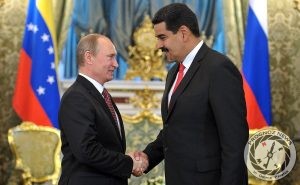The United States, Venezuela and Russia

By Matthew Parish, Associate Editor
Since early September 2025 Washington has paired its claim that Venezuelan President Nicolás Maduro is tied to cartel activity with a visible military build-up and a campaign of lethal interdictions at sea. The United States has expanded sanctions and terrorism-related designations, raised its reward for information leading to Maduro’s arrest to up to $50 million, and is now operating major naval and air assets in the Caribbean and eastern Pacific while publicly framing alleged traffickers as unlawful combatants. Together these moves are designed to sever revenue lines that US officials say bind parts of Venezuela’s security apparatus to organised crime, and to raise the personal costs for the leadership around Maduro.
What has changed on the US side (September–November 2025)
-
Lethal interdictions at sea
Since 1–2 September the United States has carried out a series of strikes against fast boats she says were crewed by narcotics traffickers linked to Tren de Aragua (a substantial Venezuelan gang) and Colombia’s ELN (a fringe Marxist rebel group). Public tallies by mainstream outlets and US statements put the number of destroyed vessels at roughly a dozen-plus and fatalities at around sixty; the Pentagon has not released boat-by-boat evidentiary packets into the public domain, a continuing point of contention for critics in Congress and in the region.
-
Force posture and signalling
The United States surged forces to the southern Caribbean, with reporting on the deployment of the USS Gerald R. Ford carrier strike group and additional warships, aircraft and Marines. The build-up is officially tied to counter-narcotics and maritime security; diplomatically and militarily it also functions as coercive leverage against Caracas.
-
Legal and policy architecture
The administration’s January executive action created pathways to designate certain Western Hemisphere criminal organisations as Foreign Terrorist Organizations; in February, the State Department designated Tren de Araguaalongside major Mexican cartels. In late July, OFAC sanctioned the Cartel de los Soles (a Venezuelan drug cartel run by senior members of the Venezuelan armed forces) as a Specially Designated Global Terrorist entity, and notably used language asserting it is “headed by Maduro.” Washington then lifted the reward for information leading to Maduro’s arrest to “up to” $50 million on 7 August. These instruments do not substitute for courtroom proof, but they clarify Washington’s intent and underpin expanded authorities for interdiction and sanctions.
-
Regional reverberations
Operations have strained ties with neighbours and triggered Venezuelan counter-moves, including the suspension of energy cooperation with Trinidad and Tobago after a US destroyer’s port visit for exercises. The combined naval and air posture is meant both to interdict maritime routes and to deter Venezuela (and any external patrons) from testing US red lines at sea.
Does this new posture strengthen the US public case?
It strengthens pressure; it does not, by itself, resolve the evidentiary gap. The most detailed public scaffolding remains the Department of Justice indictments unsealed in March 2020 and subsequent sanctions cases. The 2025 terrorism designations and OFAC’s formulation about Cartel de los Soles being “headed by Maduro” are politically weighty; but without declassified intercepts, financial trails, or controlled-delivery exhibits tying Maduro personally to specific shipments post-2020, the allegation remains plausible rather than publicly proven.
Russia’s position and recent activity
Moscow has condemned the US use of force as “excessive”, tied its rhetoric to defence of Venezuelan sovereignty, and pointed to a strategic partnership agreement signed by Vladimir Putin and Nicolás Maduro in May 2025 that elevated energy and wider cooperation. Reporting indicates at least one heavy Russian Il-76 transport aircraft recently reached Caracas via Africa, and US documents cited by the Washington Post describe Maduro’s requests for radars, aircraft parts, longer-range drones, GPS-spoofing/war-reserve EW kit, and possibly missiles. These are consistent with what Caracas would need to stiffen air defence and coastal denial in a crisis.
What practical measures could Russia take for Maduro?
Below are realistic lines of assistance, ordered from most to least plausible, and graded for impact and risk.
-
Sustainment, spares and specialists for legacy Russian systems (highly plausible; moderate impact; low-to-moderate risk)
Venezuela already fields Russian-origin air defence (S-300VM/Antey-2500, Buk-M2E) and Su-30MK2V strike fighters with anti-ship options. The single most valuable Russian contribution is technical sustainment: engines, avionics and missile spares; radar and command-and-control maintenance; on-site specialists to restore readiness rates; and limited electronic warfare support. This is cheaper than major new deliveries, complicates US targeting, and can be masked as routine contractor activity. It still risks interdiction and further sanctions, but the legal threshold is lower than overt force deployments.
-
Intelligence, surveillance and reconnaissance support (plausible; moderate impact; moderate risk)
Russia can provide commercial or military-grade satellite tasking on Caribbean sea lanes, signals intelligence sharing on US/regional patrol patterns, and advisory support to integrate coastal radars with mobile SAM batteries. Much of this can be delivered remotely or via small teams arriving on civilian flights. The benefit to Caracas would be improved cueing for air defences and faster relocation of mobile assets; the risk to Moscow is largely political if exposure is clear.
-
Supply of expendable air-defence munitions, coastal-denial kit and counter-UAS (plausible; moderate impact; moderate risk)
Short-range point-defence missiles, MANPADS reloads, counter-UAS jammers, and coastal surveillance drones are relatively cheap to move and can tighten the air and littoral picture around Caracas and key bases. Russia could also route commercial-looking EW equipment that degrades GPS-guided glide-munitions, even if only episodically. The impact is defensive and local; the risk lies in interdiction and attribution if shipments are seized.
-
Limited presence missions and signalling deployments (possible; high signalling value; higher risk)
Short-duration visits by Russian long-range aircraft or warships, or small training contingents under bilateral agreements, would deliver political deterrence without committing to combat. Moscow has used Tu-160 bomber visits and troop flights before; repeating such moves now would be risky but feasible. It raises escalation risks if US operations continue close to Venezuelan shores, and Russia’s own commitments elsewhere (Ukraine, Middle East) constrain duration and frequency.
-
Covert security contractors or “Africa Corps” style advisers (possible; limited military value; substantial political risk)
Post-Wagner restructuring makes any large-scale covert deployment harder, and Caracas does not face a ground insurgency that such forces typically support. Small teams for VIP protection, facility hardening or cyber-defence are plausible, but their exposure could harm Moscow’s narrative and invite targeted US or partner sanctions.
-
Expanded energy and financial lifelines (highly plausible; strategic impact over time; sanctions exposure risk)
A deeper Russia–Venezuela oil-for-cash (or oil-for-services) channel, using shadow-fleet logistics and barter arrangements, could offset some US pressure. Russia has long experience brokering Venezuelan barrels; however, intensified US sanctions on Russian oil entities would complicate scaling these channels without Chinese facilitation. The payoff to Caracas is fiscal breathing room; the risk to Moscow is incremental sanctions and seizures.
-
Delivery of new marquee weapons (unlikely in the near term; high risk; high cost)
Supplying advanced stand-off missiles, additional Su-30s, or new long-range SAMs would meaningfully raise US strike costs but is improbable now: cost, export-control politics, battlefield stock drawdowns and the logistics of moving heavy kit under intense scrutiny make this a poor fit. Russia’s public rhetoric outstrips what her industrial base and logistics can credibly deliver in weeks, as opposed to years.
Constraints on Russian assistance
-
Bandwidth and priorities: war-related demands limit Russia’s ability to surge high-end equipment or crews to the Caribbean.
-
Sanctions and interdiction risk: US and partner enforcement on shipping, insurance and finance raises the cost and visibility of any material transfers.
-
Escalation management: overt Russian military presence near an active US naval operation risks an incident at sea or in the air, which Moscow is likely keen to avoid.
Analytical judgements
-
The US has materially escalated pressure on Caracas through maritime strikes, a strengthened regional military posture, and a sharpened legal framework that casts cartels and allied gangs as terrorists. This hardens Washington’s narrative that Maduro is intertwined with cartel structures, while leaving the public evidentiary record largely where it stood: plausible, but not proven with new declassified specifics tying Maduro personally to recent trafficking events.
-
Russia can help Maduro most effectively by improving readiness of existing systems, sharing ISR and providing limited defensive materiel; splashier options (bomber visits, ship calls) are available but carry escalation risks and do little to change the military balance if Washington sustains its interdiction campaign at sea. The probability of rapid Russian delivery of new strategic weapons is low.
7 Views





